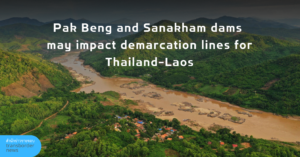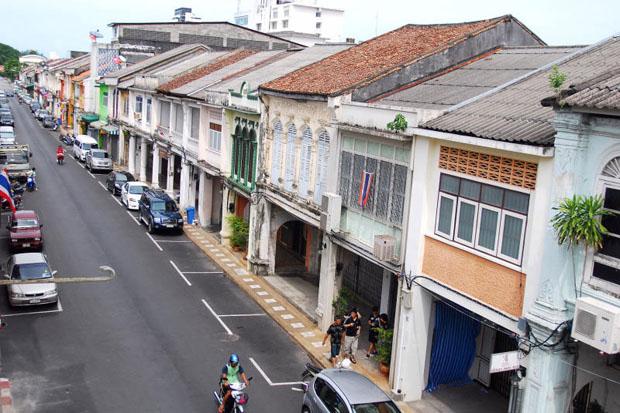 Pak Beng dam and Sanakham dam may impact demarcation lines for Thailand-Laos
Pak Beng dam and Sanakham dam may impact demarcation lines for Thailand-Laos
On 7 September 2022, there have reportedly been outcries from the people living by the Mekong, particularly in Chiang Rai and Loei, following the reports that the construction of the Pak Beng Dam on the Mekong will press ahead. The proposed Pak Beng Dam is located merely 97 kilometers from the Thai border in Chiang Rai, whereas the Sanakham Dam is merely 1.5 kilometers from the Thai border in Loei. It is believed that the construction of the two dams shall impact the demarcation lines between Thailand and Laos which are now based on the deep water channels in the Mekong based on the Franco-Thai Treaty. Despite being located in Laos’ territory, the two big dams are of close proximity to the Thai border.
Fact-finding trips have ben made by reporters to explore the Mekong at Kaeng Pha Dai, Wiang Kaen District, Chiang Rai the last point at the Thai border before the water empties into the Mekong, then flows to Laos and eventually returns to the Thai border. in Loei. During dry season, large rapids in this area would emerge when the water in the Mekong dries up leaving islets along the Thai border. The picturesque Kaeng Pha Dai is teemed with gorgeous boulders and patches of sandbank, a well-known tourist attraction. Local people often hold their ceremonies including wedding and other festivals here. Nevertheless, the construction of Pak Beng Dam will likely to turn the area into a reservoir leaving it flooded all year round.
Reporters have interviewed Mr. Thongsuk Inthawong, former Village Headman of Ban Huay Luk, Wiang Kaen District, and leader of the people opposed to the construction of Pak Beng Dam. According to Thongsuk, around November 2019, the Department of Water Resources, Ministry of Natural Resources and Environmental Conservation, has informed the village through a letter about the suspension of the construction of Pak Beng Dam following the concern raised by the villagers about the impact at a public hearing. The villagers then raised alarm that the construction of the dam may lead to flood and inundation of thousands of Rai of farmland, agricultural land, and residential area of the villagers.
Thongsuk said that if the dam is built up to the reported height, it will cause flood all over including in Ban Huay Luk, Ban Yai Nua, Ban Yai Tai, Ban Muay Yai, and Ban Tha Kham causing damage to two Tambons including Muang Yai. and Lai Ngao located by the Mekong. The flood will expand to low-lying area along the tributaries including the Ngao River affecting paddy field and Pomelo and corn plantation along the river.
“If the dam is built, (with storage) at 315 meters high from mean sea level, it will excessively elevate the level of runoff of the dam. Such height of water level would be equal to the height during the massive flood in 2009 when it was around 305-310 MSL. Just that level, the flood would already devastate large swathe of land. If this dam is built, all the rapids will disappear all year round. For local people, Kaeng Pha Dai serves as a source of food abundant with fish. People can just lay their nets to catch it for the long stretch of water. If everything will get inundated, a very important fishing ground will be lost,” said Thongsuk.
Thongsuk further said that it is even more concerning considering the garbage and toxic substance during the flood since people in Thailand and Laos use toxic chemicals and herbicide in agriculture which are flushed into the Mekong. With the stagnant water, it will cause the spread of ailments and skin disease among the people. Until now, whenever there is flood in low-lying area along the tributaries, it will cause garbage to float around. During high tide, the waste just floats about everywhere. The dam will simply confine the garbage close to our houses.
According to the former Village Headman, of late, officers from Gulf (the developer of Pak Beng Dam) have come twice to the village to organize activities with youth. They have tried to reach out to local children and youth and the schools.
Mr. Pornsawan Boonthan, Chairperson of Muang Yai Tambon Municipality Council said that the villagers are quite concerned about the prospect of the Pak Beng Dam’s construction. If they really want to press ahead with this, the government should come and explain to locals, the contractors and other companies, as well.
“During our last meeting with them, I used to ask representatives from the government if they could confirm that the dam’s construction will not cause flood in our village. They refused to confirm this. The issue has garnered traction since it may inflict suffering on the villagers. I am ready to attend any meeting. I used to challenge them asking them to explain where the flood will reach to. Just confirm it. All of a sudden, they now want us to sign the agreements. How could we concede to that? I used to seem examples of how villagers have been relocated due to a dam. They had to eke out their living. Although they received some help early on, later, they were left to bear the brunt” said Pornsawan.
Mr. Montree Chantawong, Coordinator of the Mekong Butterfly said that the Sanakham Dam will be located upstream along the Thailand-Laos border up to five kilometers along the Mekong. The storage and discharge of water from Sanakham Dam will cause immense impacts as far as the alteration of natural borderline along the Mekong is concerned and transboundary impacts. There have yet been studies on such impacts by the Thai agencies.
The Coordinator said that the impacts on the alteration of natural borderline between Thailand and Loas along the Mekong owing to the Sanakham Dam will be visible along the Mekong for about 100 kilometers from Chiang Khan and Pak Chom Districts, Loei to Sangkhom, Sri Chiang Mai, Tha Bo, and Muang Districts, Nong Khai (which receive water flown from four other dams, Pak Beng, Luang Prabang, Xayaburi and Pak Lay Dams). According to the last version of the Technical Review Report (TRR) for the Sanakham hydropower project (SNHPP) on 4 November 2021 prepared by the Secretariat of the Mekong River Commission, the Sanakham Dam will cause sedimentation which will immensely accelerate the rate of erosion downstream. .
Montree said that according to the evaluation of accumulated impacts from the sedimentation, this will give rise to severe erosion of the riverbank downstream for the stretch of 100 kilometers down the Mekong River. It could reach out to as far as Vientiane. During the seven years after the operation of the dam, the impact will cause alteration of the water channels which form a natural demarcation line in the Mekong between Thailand and Laos. Although the overall shape and form (including rapids and boulders) of the Mainstream Mekong will not change that much, but the change made to riverbed and sandbank will continue further on due to the pattern of the transport of sediment.
Montree further said that it will cause transboundary impact. According to the Executive Summary in the Rapid Assessment of Transboundary Impacts. Caused by Rapid Water Fluctuation Downstream of the Sanakham Hydropower Project prepared by MRCs, it states that the amplitude of the water level changes downstream the Sanakham Dam in Chiang Khan District, Loei, could be as high as 3.50 meters within 24 hours or one day. Nevertheless, according to the MRC’s new criteria to estimate the water level changes of the Mekong, the changes of the water level in Chiang Khan could still be as much as 12.9-1.34 centimeters within one house (or 0.129-1.34 meter/hour).
“There will be the losses of economic value in the fishery and agricultural sectors, community-based tourism and business tourism, damage to infrastructure which relies on water supply from the Mekong, erosion of the newly constructed embankment of the Mekong. Therefore, it is incumbent on the Thai government to monitor the impact on international borderlines and the impact on the community and local economy. Studies should be made to explore the impacts as much as possible based on public participation prior to the signing of the power purchase agreement which may cause a direct obligation to construct the dam” said Montree.
According to reports, the Network of Thai People in Eight Mekong Provinces has submitted a letter of petition to the Standing Committee on Foreign Affairs, the House of Representatives demanding an investigation into the construction of the Pak Beng and Sanakham Dams which may affect demarcation lines at. Thailand’s border. The Committee shall convene on 8 September at the Parliament and will invite representatives of the complainants including the people from the Mekong River Basin and representatives from concerned agencies including the Department of Treaties and Legal Affairs, the Royal Thai Survey Department and the Ministry of Energy to. explain.
[This is a translation of original Thai language news report by Transborder News https://transbordernews.in.th/home/?p=32338 ]
Source: https://transbordernews.in.th/home/?p=32405


